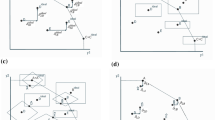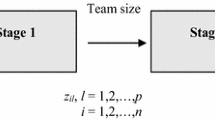Abstract
Measuring the performance of participating nations in the Olympic Games is an important application of data envelopment analysis (DEA). Prior literature only considers participating nations’ performance in the Summer Olympic Games. It may be unfair to some nations who are good at the Winter Olympics, but poor at the Summer Olympics. Therefore, we believe it is better to consider the two Olympics together when measuring performance of participants. This paper treats the two Olympics as a parallel system in which each subsystem corresponds to a Summer Olympics or a Winter Olympics, and extends a parallel DEA approach to evaluate the efficiency of each participant. An efficiency decomposition procedure is proposed to obtain the efficiency rang of each Olympic subsystem. Finally, we apply the proposed approach to the latest real data set of the 2012 Summer Olympics and 2010 Winter Olympics.


Similar content being viewed by others
Notes
In this paper, we set \(\varepsilon =\hbox {0.01}\). The smaller \(\varepsilon \) value we select, the more impossible the maximum efficiency scores will be missed.
References
Ali, A. I. (1994). Computational aspects of DEA. In A. Charnes, W. W. Cooper, A. Lewin, & L. M. Seiford (Eds.), Data envelopment analysis: Theory, methodology and applications (pp. 63–88). Boston: Kluwer.
Amirteimoori, A., & Nashtaei, R. A. (2006). The role of time in multi-component efficiency analysis: An application. Applied Mathematics and Computation, 177(1), 11–17.
Azizi, H., & Wang, Y. M. (2013). Improved DEA models for measuring interval efficiencies of decision-making units. Measurement, 46(3), 1325–1332.
Beasley, J. E. (1995). Determining teaching and research efficiencies. Journal of the Operational Research Society, 46, 441–452.
Bogetoft, P. (1997). DEA-based yardstick competition: The optimality of best practice regulation. Annals of Operations Research, 73, 277–298.
Bougnol, M. L., & Dulá, J. H. (2006). Validating DEA as a ranking tool: An application of DEA to assess performance in higher education. Annals of Operations Research, 145(1), 339–365.
Castelli, L., Pesenti, R., & Ukovich, W. (2010). A classification of DEA models when the internal structure of the decision making units is considered. Annals of Operations Research, 173(1), 207–235.
Charnes, A., Cooper, W. W., & Rhodes, E. (1978). Measuring the efficiency of decision making units. European Journal of Operational Research, 2(6), 429–444.
Chen, Y., Cook, W. D., Li, N., & Zhu, J. (2009). Additive efficiency decomposition in two-stage DEA. European Journal of Operational Research, 196(3), 1170–1176.
Chen, Y., Du, J., David Sherman, H., & Zhu, J. (2010). DEA model with shared resources and efficiency decomposition. European Journal of Operational Research, 207(1), 339–349.
Chen, W. C., & Johnson, A. L. (2010). The dynamics of performance space of Major League Baseball pitchers 1871–2006. Annals of Operations Research, 181(1), 287–302.
Chen, Y., Liang, L., & Yang, F. (2006). A DEA game model approach to supply chain efficiency. Annals of Operations Research, 145(1), 5–13.
Chiang, C. I., Hwang, M. J., & Liu, Y. H. (2011). Determining a common set of weights in a DEA problem using a separation vector. Mathematical and Computer Modelling, 54(9), 2464–2470.
Churilov, L., & Flitman, A. (2006). Towards fair ranking of Olympics achievements: The case of Sydney 2000. Computers & Operations Research, 33(7), 2057–2082.
Cook, W. D., & Green, R. H. (2004). Multicomponent efficiency measurement and core business identification in multiplant firms: A DEA model. European Journal of Operational Research, 157(3), 540–551.
Cook, W. D., Hababou, M., & Tuenter, H. J. (2000). Multicomponent efficiency measurement and shared inputs in data envelopment analysis: An application to sales and service performance in bank branches. Journal of Productivity Analysis, 14(3), 209–224.
Cook, W. D., & Zhu, J. (2010). Context-dependent performance standards in DEA. Annals of Operations Research, 173(1), 163–175.
De França, J. M. F., de Figueiredo, J. N., & dos Santos Lapa, J. (2010). A DEA methodology to evaluate the impact of information asymmetry on the efficiency of not-for-profit organizations with an application to higher education in Brazil. Annals of Operations Research, 173(1), 39–56.
Du, J., Liang, L., Chen, Y., Cook, W. D., & Zhu, J. (2011). A bargaining game model for measuring performance of two-stage network structures. European Journal of Operational Research, 210(2), 390–397.
Du, J., Wang, J., Chen, Y., Chou, S. Y., & Zhu, J. (2014). Incorporating health outcomes in Pennsylvania hospital efficiency: An additive super-efficiency DEA approach. Annals of Operations Research, 221, 161–172.
Emrouznejad, A. (2014). Advances in data envelopment analysis. Annals of Operations Research, 214, 1–4.
Emrouznejad, A., Anouze, A. L., & Thanassoulis, E. (2010). A semi-oriented radial measure for measuring the efficiency of decision making units with negative data, using DEA. European Journal of Operational Research, 200(1), 297–304.
Emrouznejad, A., Parker, B. R., & Tavares, G. (2008). Evaluation of research in efficiency and productivity: A survey and analysis of the first 30 years of scholarly literature in DEA. Socio-Economic Planning Sciences, 42(3), 151–157.
Färe, R., Grabowski, R., Grosskopf, S., & Kraft, S. (1997). Efficiency of a fixed but allocatable input: A non-parametric approach. Economics Letters, 56(2), 187–193.
Grigoroudis, E., Tsitsiridi, E., & Zopounidis, C. (2013). Linking customer satisfaction, employee appraisal, and business performance: An evaluation methodology in the banking sector. Annals of Operations Research, 205(1), 5–27.
Hai, H. L. (2007). Using vote-ranking and cross-evaluation methods to assess the performance of nations at the Olympics. WSEAS Transactions on Systems, 6(6), 1196–1198.
Jahanshahloo, G. R., Amirteimoori, A. R., & Kordrostami, S. (2004). Measuring the multi-component efficiency with shared inputs and outputs in data envelopment analysis. Applied Mathematics and Computation, 155(1), 283–293.
Kao, C. (2012). Efficiency decomposition for parallel production systems. Journal of the Operational Research Society, 63(1), 64–71.
Kao, C., & Hwang, S. N. (2008). Efficiency decomposition in two-stage data envelopment analysis: An application to non-life insurance companies in Taiwan. European Journal of Operational Research, 185(1), 418–429.
Kao, C., & Lin, P. H. (2012). Efficiency of parallel production systems with fuzzy data. Fuzzy Sets and Systems, 198, 83–98.
Khodabakhshi, M., & Aryavash, K. (2014). The fair allocation of common fixed cost or revenue using DEA concept. Annals of Operations Research, 214(1), 187–194.
Li, Y., Chen, Y., Liang, L., & Xie, J. (2012). DEA models for extended two-stage network structures. Omega, 40(5), 611–618.
Li, Y., Liang, L., Chen, Y., & Morita, H. (2008). Models for measuring and benchmarking olympics achievements. Omega, 36(6), 933–940.
Liang, L., Cook, W. D., & Zhu, J. (2008). DEA models for two-stage processes: Game approach and efficiency decomposition. Naval Research Logistics (NRL), 55(7), 643–653.
Lins, M. P. E., Gomes, E. G., Soares de Mello, J. C. C., & Soares de Mello, A. J. R. (2003). Olympic ranking based on a zero sum gains DEA model. European Journal of Operational Research, 148(2), 312–322.
Lozano, S., Villa, G., Guerrero, F., & Cortés, P. (2002). Measuring the performance of nations at the Summer Olympics using data envelopment analysis. Journal of the Operational Research Society, 53(5), 501–511.
Molinero, C. M. (1996). On the joint determination of efficiencies in a data envelopment analysis context. Journal of the Operational Research Society, 47(10), 1273–1279.
Moreno, P., & Lozano, S. (2014). A network DEA assessment of team efficiency in the NBA. Annals of Operations Research, 214(1), 99–124.
Prior, D. (2006). Efficiency and total quality management in health care organizations: A dynamic frontier approach. Annals of Operations Research, 145(1), 281–299.
Soares de Mello, J. C. C. B., Angulo-Meza, L., & Da Silva, B. P. B. (2009). A ranking for the Olympic Games with unitary input DEA models. IMA Journal of Management Mathematics, 20(2), 201–211.
Soares de Mello, J. C. C. B., Angulo-Meza, L., & Lacerda, F. G. (2012). A dea model with a non discritionary variable for olympic evaluation. Pesquisa Operacional, 32(1), 21–30.
Tsai, P. F., & Mar Molinero, C. (2002). A variable returns to scale data envelopment analysis model for the joint determination of efficiencies with an example of the UK health service. European Journal of Operational Research, 141(1), 21–38.
Wu, J., Liang, L., & Chen, Y. (2009). DEA game cross-efficiency approach to Olympic rankings. Omega, 37(4), 909–918.
Wu, J., Liang, L., & Yang, F. (2009). Achievement and benchmarking of countries at the Summer Olympics using cross efficiency evaluation method. European Journal of Operational Research, 197(2), 722–730.
Wu, J., Zhou, Z. X., & Liang, L. (2010). Measuring the performance of nations at Beijing Summer Olympics using integer-valued DEA model. Journal of Sports Economics, 11(5), 549–566.
Yang, C. C. (2014). An enhanced DEA model for decomposition of technical efficiency in banking. Annals of Operations Research, 214, 167–185.
Yang, C. H., Lin, H. Y., & Chen, C. P. (2014). Measuring the efficiency of NBA teams: Additive efficiency decomposition in two-stage DEA. Annals of Operations Research, 217(1), 565–589.
Yang, Y., Ma, B., & Koike, M. (2000). Efficiency-measuring DEA model for production system with k independent subsystems. Journal of the Operations Research Society of Japan-Keiei Kagaku, 43(3), 343–354.
Yu, M. M. (2008). Measuring the efficiency and return to scale status of multi-mode bus transit-evidence from Taiwan’s bus system. Applied Economics Letters, 15(8), 647–653.
Zhang, D., Li, X., Meng, W., & Liu, W. (2009). Measuring the performance of nations at the Olympic Games using DEA models with different preferences & star. Journal of the Operational Research Society, 60(7), 983–990.
Zha, Y., & Liang, L. (2010). Two-stage cooperation model with input freely distributed among the stages. European Journal of Operational Research, 205(2), 332–338.
Zhou, Z., Wang, M., Ding, H., Ma, C., & Liu, W. (2013). Further study of production possibility set and performance evaluation model in supply chain DEA. Annals of Operations Research, 206(1), 585–592.
Acknowledgments
The authors thank the editor-in-chief Professor Endre Boros and the reviewers for their constructive comments and suggestions, which have helped to improve the quality of this paper. The authors also thank Professor Alec Morton for his valuable suggestions and his technical check on this paper. This research is supported by National Natural Science Foundation of China under Grants (No. 61101219, 71271196), the Foundation for Innovative Research Groups of the National Natural Science Foundation of China (No. 71121061), the Fund for International Cooperation and Exchange of the National Natural Science Foundation of China (No. 71110107024) and the Fundamental Research Funds for the Central Universities.
Author information
Authors and Affiliations
Corresponding authors
Appendices
Appendix 1
Theorem 1
If the overall Olympic Games system of \(DMU_{0}\) is efficient, then its each subsystem is efficient, namely \(e_{0}^{1} =e_{0}^{2} =1\).
Proof
Since we have \(\theta _0 =\lambda _0^1 \theta _0^1 +\lambda _0^2 \theta _0^2 \) which is a convex combination of \(\theta _0^1 \) and \(\theta _0^2 \). It is apparently that \(\theta _0 =1\) if and only if \(\theta _0^{1} =\theta _0^2 =1\). Hence, the overall Olympic parallel system of the given \(DMU_0 \) is efficient due to \(e_0 =1/\theta _0 =1\), and meanwhile, the two Olympic subsystems are also efficient due to \(e_0^1 =1/\theta _0^1 =1\) and \(e_0^2 =1/\theta _0^2 =1\). In other words, the overall Olympic parallel system is efficient, then its two Olympic subsystems are efficient. Thus, Theorem 1 has been completely proven. \(\square \)
Appendix 2
Theorem 2
If the overall Olympic Games system of \(DMU_{0}\) is efficient, then \(\underline{E_0^k }=\overline{E_0^k } =1,\forall k\)
Proof
Theorem 1 has proved that the overall Olympic Games system of \(DMU_{0}\) is efficient, then its each subsystem is efficient, namely \(e_{0}^{1} =e_{0}^{2} =1\). In other words, the subsystem has a unique solution equals to 1, thus, the maximum and minimum efficiencies were only identified, namely \(\underline{E_0^k }=\overline{E_0^k } =1,\forall k\). Then Theorem 2 has been proved. \(\square \)
Rights and permissions
About this article
Cite this article
Lei, X., Li, Y., Xie, Q. et al. Measuring Olympics achievements based on a parallel DEA approach. Ann Oper Res 226, 379–396 (2015). https://doi.org/10.1007/s10479-014-1708-1
Published:
Issue Date:
DOI: https://doi.org/10.1007/s10479-014-1708-1




